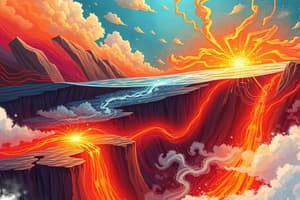Podcast
Questions and Answers
What is heat transfer?
What is heat transfer?
Heat transfer is the movement of energy from a warmer object to a cooler object.
What are the three types of heat transfer?
What are the three types of heat transfer?
- Radiation (correct)
- Conduction (correct)
- Convection (correct)
- Evaporation
What is radiation?
What is radiation?
The transfer of energy without direct contact between heat source and object.
What is conduction?
What is conduction?
What is convection?
What is convection?
What happens during convection in a pot of soup?
What happens during convection in a pot of soup?
What is a convection current?
What is a convection current?
What sets a convection current in motion?
What sets a convection current in motion?
How long do convection currents continue?
How long do convection currents continue?
Where do convection currents flow in the Earth?
Where do convection currents flow in the Earth?
What is the heat source for the convection currents in the Earth?
What is the heat source for the convection currents in the Earth?
How do convection currents in the Earth move?
How do convection currents in the Earth move?
What is density?
What is density?
How does density affect convection currents?
How does density affect convection currents?
Study Notes
Heat Transfer
- Movement of energy occurs from a warmer object to a cooler one.
- Three primary forms of heat transfer: radiation, conduction, and convection.
Types of Heat Transfer
- Radiation: Energy transfer without direct contact; example includes sunlight warming Earth's surface.
- Conduction: Heat transfer through direct contact of particles; for instance, a metal spoon heating in hot soup.
- Convection: Heat transfer through movement of heated fluids (liquids and gases); occurs due to temperature and density differences.
Convection Explained
- Convection involves the flow of heated particles in a fluid that transfers heat energy within the fluid.
- Key example: Heating a pot of soup, creating rising warm soup and sinking cooler soup.
Convection Current Dynamics
- A convection current is the ongoing flow that transfers heat within a fluid.
- Initiating factors include heating and cooling of the fluid, density changes, and gravity.
- Currents persist as long as heat is continuously added to the fluid.
Earth's Convection Currents
- Convection currents are present in the Earth's asthenosphere.
- The heat source comes from Earth's core and the mantle.
- Hot mantle columns rise slowly, spreading and pushing cooler material downward, which then sinks back into the asthenosphere.
Density and Its Role
- Density measures mass per volume of a substance.
- Heating a liquid or gas causes particles to move faster and spread apart, reducing density.
- Cooling results in particles moving closer and increasing density, influencing convection current behavior.
Studying That Suits You
Use AI to generate personalized quizzes and flashcards to suit your learning preferences.
Description
Explore the fundamentals of heat transfer, focusing on radiation, conduction, and convection. This quiz covers key concepts, examples, and dynamics of convection currents. Test your understanding of how energy moves in different forms!




